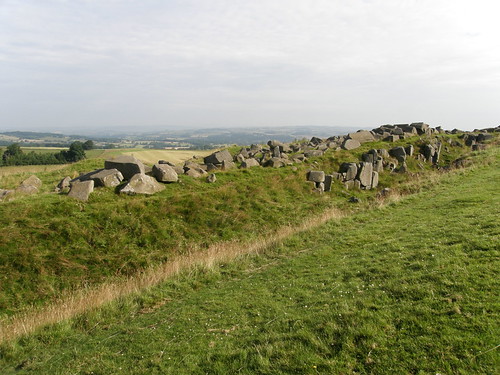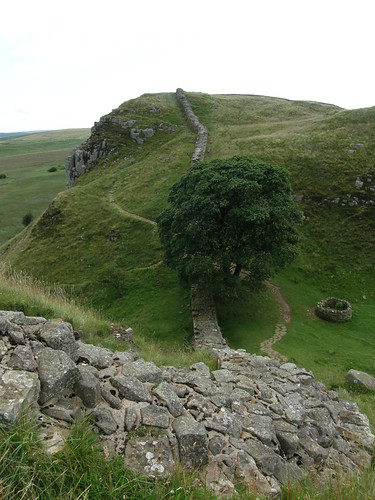Our final day on Hadrian’s Wall. We caught the early bus from outside the hostel. The sunshine had returned and picking up from Brocolitia the landscape felt more welcoming with the sun on it. Our steady ascent continued until we reached Limestone Corner, where the ditch which accompanied the Wall is very evident, and also a jumble of large limestone boulders. Shortly beyond the boulders there’s a trig pillar….
The Wall had been noticeable by its absence for a while, but as you drop away from Limestone Corner there’s a couple of lengthy, impressive sections.
At Black Carts turret we stopped briefly for a drink and a snack.
Dropping down into the valley of the North Tyne we found ourselves in a new environment; for much of the last three days we had walked over rough moorland and sheep cropped turf; we were now passing through hedged fields, some of them full of vegetables. We watched four buzzards circling above a small copse. The national trail diverted considerably from what my book and map led me to expect, but fortunately it was well sign-posted.
We’d only a short walk to reach the fort at Chesters and with our early start we were there soon after it opened. My original plan would have had us arriving at Chesters the previous afternoon and starting again from there rather than Brocolitia. Because we hadn’t, my intention to walk out to Hexham was now a little in doubt. Already slightly leaky, my plan now foundered on the children’s activities on offer at Chesters. For two hours the kids were royally entertained by three young English Heritage employees. They were encouraged to think like archaeologists. They examined replica Roman household objects and guessed their purpose. They participated in a mock dig and then tried to decide from the odds and ends they had found what kind of person had owned them.
They dressed as Roman soldiers…
And although B looks very serious here, they were both thrilled. Finally, they acted out some tales of Roman life.
By the time they’d finished, we were ready for some lunch, which we bought from the little cafe on the site, and ate at the picnic tables outside. The sun was still shining, but it was extremely sticky and to west the sky was black. Sure enough, our meal was seasoned by a dash of lightening and a soupcon of thunder. I thought we would have a sprinkling of rain too, but it never really materialised.
I’d already had a swift tour of the fort whilst the kids were archaeologising, but naturally, they wanted to have a gander themselves. The forts on the Wall all seem to have a similar layout. A perimeter wall with gates at each point of the compass. And within: some barracks…
A principia or headquarters, the administrative and religious centre of the fort. At Chesters this contains an underground strong-room…
…currently flooded. This is where the payroll would be stored, When this was excavated a studded oak door was still in place and some denarii were found on the floor.
Next to the principia: the commandant’s house. At Chesters this building was refurbished at some point, with the insertion of hypocausts for under-floor heating, and the addition of a small bath-house.
Usually there are granaries too, but at Chesters there’s just a grassy space where you might expect to see those.
Just outside the fort, where the Romans bridged the River North Tyne (you can just about make out the Wall and the hint of a bridge abutment on the far bank)….
…is another bath-house. This is so well preserved that, for once, it’s relatively easy to imagine the building in use, and to understand what those uses were.
I could picture Romans undressing for their baths and dumping their togas in these alcoves…
…washing away the cares of the day in a hot bath…
…and relaxing in a hot room….
The gaps between these flags reveal a fairly substantial space below: the stoke hole…
Of course, A and B just had to have a crawl in there. B emerged with a handful of small bones and the conviction that no archaeologist had ever ventured into the hole, “Because they are all too frightened.” (If anybody from English Heritage wants any of those rodent bones, B has them all in his bedroom.)
There’s something about squeezing into a cramped spot which appeals when you’re young. Here’s A in a water channel beneath the North gate…
We caught the AD122 for the last time, just outside the entrance to Chesters. Clearly not everywhere had avoided the rain like we had. The bus was awash both inside and out. Our luck continued to hold-out whilst we had drinks and an ice-cream outside the cafe by Hexham bus station, and long enough for us to be inside Hexham Abbey when the heavens finally opened.
On the left of this picture the large stone in the even larger alcove is the tomb-stone…
…of Flavinus, a Roman standard bearer, who is depicted riding his horse over a cowering Britain. Since the rain showed no signs of slackening, we repaired to yet another cafe. Cake for the kids, endless cups of tea for me and a quick lesson in Pontoon. (They both had a flair for going bust.)
We’d arranged to meet TBH ‘somewhere near the Abbey’ so were delighted to see her pull-up right outside our cafe. She’d come through flash floods on the A69, it seemed we’d had a very lucky escape. Which seems like an appropriate note on which to end, since that’s how I shall remember the whole trip: a very lucky escape.
Now, let’s start planning our next escape….


































































































